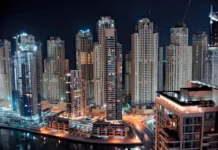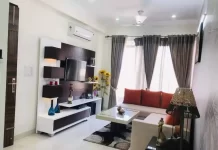The ancient rooms and foundations have been covered up and hidden from public view in a clumsy manner.
On the riverfront, the platform can be found in one of 22 rooms hidden beneath the marble in a secret red stone floor. It’s important to remember that Shah Jahan has used unlined bricks to build a doorway into a palace. Shah Jahan built this primitive blockade as a tribute to his architectural prowess. Imperial vandalism by the Moguls is kept secret from the general populace. The red stone floor of this area is directly beneath the marble platform.

View of Mumtaz’s Tomb from a Riverside
Mumtaz’s grave inside the Taj is enough for most visitors, and many don’t bother going to the river’s edge. The river can be seen in the background. The four-story marble structure at the top has two more red stone floors below it. The window on the left has just been opened, so pay attention to that. That’s a sign there are interior spaces. There are 22 rooms in the upper portion of the wall that are accessible through the arches. There are red stone arches on the fifth floor, in addition to the four marble floors. The plinth at the bottom of the picture is where you’ll find the 6th floor.
Pictures of Hindu-Painted Rooms
The secret floor of the Taj Mahal can be found in a corner of one of the rooms. Take notice of the wall’s Hindu-inspired paint stripes. The fan has been clumsily blocked to the left, allowing riverside air and light to reach it. He didn’t even bother to put up any sort of wall covering. What was the purpose of the Taj Mahal’s 22 chambers if Shah Jahan had built it as a mausoleum? What’s the reason for keeping them locked up? Shah Jahan’s unplastered bricks have been used to seal 22 rooms in a secret floor of the Taj Mahal.
The ceilings of the rooms are decorated with Hindu patterns.
A Hindu mystical artwork has been painted on the ceilings of some of the 22 secret rooms in the Taj Mahal’s hidden floor. A Taj Mahal built by Shah Jahan would not have been so secretive about its exquisitely painted interiors. Even now, if you can get the archaeology department to remove the locks, you can enter these rooms.
A passageway beneath a marble platform decorated with Hindu patterns
The 22 closed-off rooms are located on the right-hand side. An approximately 12-foot-wide and 300-foot-long corridor lies beneath the marble platform in the secret red stone floor beneath the marble. The plinth that holds up the arches has a scalloped design at the bottom that you should take note of. Even a naked plinth may be identified as Hindu because to this Hindu embellishment. Because Shah Jahan has shut down all riverbank ventilation, the hallway is absolutely black.
Hence, these are some of the Taj Mahal’s hidden mysteries that require in-depth study in order to uncover the genuine truth. Don’t get rid of your interest in the site, go and see for yourself what all the fuss is about.










